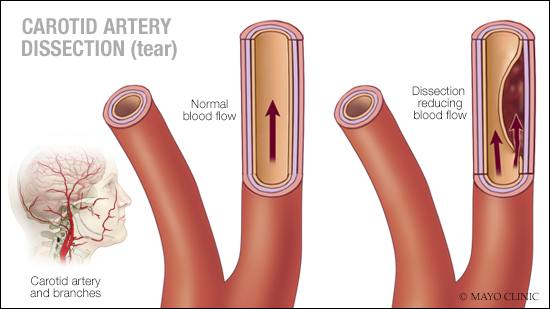-
Mayo Clinic Q and A: Treating a carotid artery tear

DEAR MAYO CLINIC: My doctor told me I had a transient ischemic attack caused by an internal tear in my carotid artery. So far, I’m only being treated with a drug to prevent blood clotting. Shouldn’t the tear be fixed?
ANSWER: It’s not uncommon after an internal tear in the carotid artery to see if the tear heals on its own before having it surgically repaired. In the meantime, taking a blood thinning medication will make it less likely that a blood clot will form, which is the main concern for someone in your situation.
Your carotid arteries are among the main vessels that carry blood to your brain. You feel the carotid artery when taking a neck pulse. An artery tear, also called a “dissection,” occurs when layers of the interior arterial walls separate. With carotid dissection, the dissection rarely goes completely through the artery due to its elastic outer layers.
But it’s still a dangerous situation. Blood in the separated layers of the vessel wall can lead to blood clot formation. A clot can grow, creating an inward bulge that may partially or fully block blood flow of the artery. More commonly, clots can break free of the dissection area and block an artery supplying blood to a portion of the brain. The result is a stroke or a transient ischemic attack.
A transient ischemic attack is common but doesn’t always occur with carotid dissection. Other symptoms of carotid dissection include headaches and neck pain. Horner syndrome, a condition with an abrupt onset in which one pupil is smaller than the other and the eyelid may droop, also can be a sign of a carotid dissection. If you have a stroke due to carotid dissection, the first priority is emergency treatment of the stroke or transient ischemic attack.
Aside from that, the main danger of carotid dissection is a stroke — or a second stroke — caused by a blood clot. Thus, a drug to prevent clot formation is typically the go-to treatment for the first three to six months after diagnosis.
In many cases, the dissection will seal itself off or heal over time. Follow-up imaging often is performed to assess healing progress. Ask your health care provider if this would be a good next step for your situation.
Surgery is sometimes warranted, such as when transient ischemic attacks or strokes continue despite drug therapy. A decision on the method of repair is individualized and is best made after a discussion with your health care provider. (adapted from Mayo Clinic Health Letter) — Dr. Brian Chong, Radiology, Mayo Clinic, Scottsdale, Arizona







